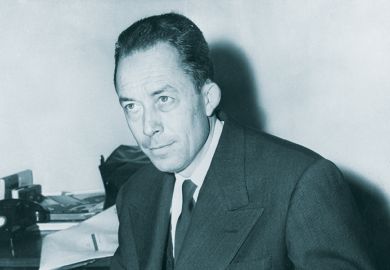Life magazine once introduced me to a literary partnership in 1980s America that attracted me so much I filed the article away. The relationship was between the anthropologist Michael Dorris and his student Louise Erdrich, whose writing had won him over. Dorris was the first unmarried man allowed by the US courts to adopt children, the smallest of whom he carried in a papoose to his lectures. Dorris and Erdrich were both one-eighth Indian, and they raised his Indian foster children together. But a little over a decade later, after their separation, I read in Time magazine of Dorris's tragic end: facing molestation charges by one of his foster daughters, he had killed himself in a motel room.
What a literary partnership that had seemed so right might really have entailed, and how the life of a writer came to be cut off, are issues dealt with in these two edited collections, Living with a Writer and Interrupted Lives (though neither mentions Dorris and Erdrich). Together they convey a sense of the writer's world. While the first book looks closely at how writers live and work, the second considers six writers who died relatively young - Angela Carter, Katherine Mansfield, Edward Thomas, Shelley, Marlowe and Sylvia Plath - and tries to imagine their lives and future work had they lived. Interrupted Lives is the culmination of a project conceived by Andrew Motion, in the form of six lectures delivered at the National Portrait Gallery in 2004.
Given the idyllic start and the horrific end of the Dorris-Erdrich partnership, it seems appropriate that Living with a Writer is divided into two parts, "The Pleasures" and "The Problems". Dale Salwak brings together 26 essays, which are mostly entertaining and almost all newly commissioned.
It opens with Malcolm Bradbury's (previously published) "The spouse in the house", which sets a standard that not all the essays reach. Bradbury issues the first warning: any notion that a writer might make an attractive and exciting partner by virtue of being sensitive, intelligent and creative ought to be banished, as writing demands that to keep going the writer be "obsessive, narcissistic, egotistical and self-excoriating". Both Nadine Gordimer and Amanda Craig agree, believing writers are monsters. This minor flaw notwithstanding, Bradbury then describes the writer's ideal partner: someone who ensures airy rooms, regular supplies of food and drink, a midday snack served without interrupting production and a heavier meal in the evening "when the odd guest may be introduced, preferably a publisher with another contract".
As for two writers who come together as partners, the one golden rule to adhere to, it seems, is a clear demarcation of work. If this is overlooked, the partnership may suffer the fate of F. Scott and Zelda Fitzgerald. Each of them started a novel on their life together. Hers took six weeks, his seven years. She ended up in a mental home, he in Hollywood. The couple Margaret Drabble and Michael Holroyd, working in different genres, prefer never to share their work in progress with each other.
Then there is the question of money. Writers generally lead a precarious existence with fragile finances. The biographers Sylvia Jukes Morris and Edmund Morris, at the start of their literary careers in New York, recall Reader's Digest assigning them to produce copy at the rate of 17 cents a word, causing Edmund to wonder if they might charge for punctuation marks, too. As for their method of working, collaboration was out of the question.
Instead, realising the gap in their temperaments, they chose to follow the imperial example of the monarchs of Spain and Portugal and divide up the literary world between them.
The light-heartedness evident in successful literary partnerships gives way, in the second part, to "The Problems". Here we learn how the failure of Agatha Christie's first marriage led to her career as a detective story writer; and how Somerset Maugham, openly homosexual but trapped in a disastrous marriage, had to fight for his very existence as a novelist. In one house after another, Maugham's wife Syrie, with no conception of a writer's needs, appropriated or even rented out his study, going so far as to offer him a small bedsit in a cheaper rented house. Admittedly, Jeffrey Meyers' essay on Maugham is written mainly with sympathy for the writer.
Although Meyers quotes at length those who support Syrie despite her faults, he does not really engage with Maugham's own demons regarding his homosexuality.
Interrupted Lives , as a collection of what-ifs about dead writers, is less engaging than the book about living partnerships. The two best contributions concern Marlowe and Shelley. Given the colourful nature of Marlowe's world, his proximity to espionage and swindling and his muscular wit, Charles Nicholl believes that Marlowe's premature death was politically inevitable. Richard Holmes, guiding us through the very redefinition of Shelley's life, which became a legend soon after his drowning, reminds us of the technical faults of his ship Don Juan , so easily overlooked. Holmes also attempts to rescue Shelley from the subjectivity of historians with theses to propound.
The partnership of Ann and William Golding, described in Living with a Writer , is what perhaps links these two books about writers. On their 33rd wedding anniversary, William wrote in his journal: "It might be a good thing to record in an unbritish way here, how much I love her, and how much she has done for me, from bed to books. For I would never have been as happy in the one with someone else, nor have written the others with someone else." Years later, when their daughter broke the news of his death to his wife Ann, she said: "But I've got so much to say to him."
Dipli Saikia holds a PhD in literature from Bristol University.
Living with a Writer
Editor - Dale Salwak
Publisher - Palgrave Macmillan
Pages - 237
Price - £18.99
ISBN - 1 4039 0476 6
Register to continue
Why register?
- Registration is free and only takes a moment
- Once registered, you can read 3 articles a month
- Sign up for our newsletter
Subscribe
Or subscribe for unlimited access to:
- Unlimited access to news, views, insights & reviews
- Digital editions
- Digital access to THE’s university and college rankings analysis
Already registered or a current subscriber? Login



